The Aggregate Expenditure Model
Lesson 18
Introduction to Aggregate Expenditure Function
Aggregate consumption function - how aggregate consumption relates to GDP
- Assume no income taxes; thus disposable income (DI) = GDP
- Autonomous Spending (A) - the y-intercept
- Spending is independent of income (i.e. GDP)
- Consumers still need a level of spending with no income
- Food
- Shelter, etc.
- MPC - the slope of the line
- Give consumers $1 more dollar in income, MPC is the amount that goes to spending
- Aggregate Expenditures (AE) - total spending by all institutions in an economy
- The y-axis
- Autonomous Spending (A) - the y-intercept
![]()
A graph of the consumption is below:
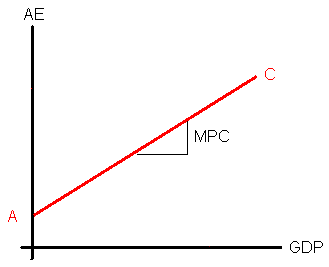
- Investment - assume investment is independent of GDP
- Gross investment (Ig) - all investment in society
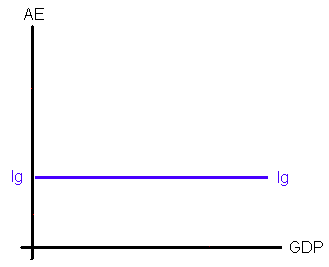
Aggregate Expenditures (AE) - restrict ourselves to consumers and business investment
![]()
- Assume Equilibrium - Aggregate Expenditures = GDP, because AE is one definition of GDP
- Equilibrium GDP is denoted as GDP*
- This is the 450 line
![]()
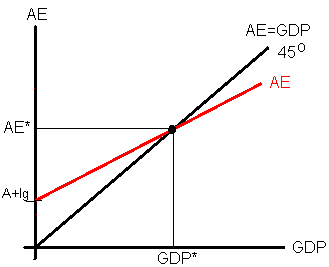
How the multiplier enters the aggregate expenditure function
Substitute the consumption function and equilibrium condition into the AE and use algebra to solve for GDP*
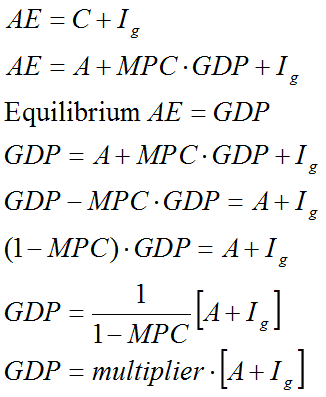
Equilibrium is stable
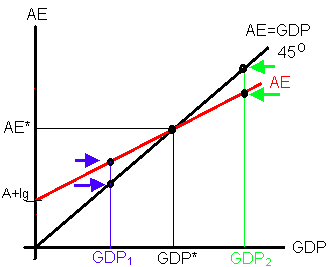
- At GDP1, Aggregate Expenditures exceeds GDP
- Businesses and consumers are spending more than the amount of goods and services produced in the economy
- Inventories are falling
- unplanned changes in inventories - businesses did not anticipate this
- Businesses increase their production of goods and services
- At GDP2, GDP exceeds Aggregate Expenditures
- Businesses and consumers are spending less than the amount of businesses are producing
- Inventories are increasing
- unplanned changes in inventories
- Businesses decrease their production of goods and services
- At GDP* = AE*, economy is in equilibrium
- Leakage - withdrawal from income / expenditure stream
- Savings is a leakage
- Injection - money is injected into income / expenditure stream
- Investment is an injection
- Consumer savings = Business Investment
- S = Ig
- No unexpected changes in business inventories
- Leakage - withdrawal from income / expenditure stream
Expanding the Aggregate Expenditure Function
International Sector
- Net exports (Xn) = Exports (X) - Imports (M)
- If Xn > 0, country exports more than what it imports
- Expands domestic production
- Has multiplier effect
- If Xn < 0, country imports more that what it exports
- Expands production for foreign country
- Negative multiplier effect
- The foreign country gets the multiplier effect
- If Xn > 0, country exports more than what it imports
- Shifting level of net exports
- Prosperity abroad
- Foreign countries have rising incomes
- They buy more exports from U.S.
- Boosts U.S. GDP
- Tariffs
- Foreign countries impose tariffs
- Decrease U.S. exports, because tariffs cause higher prices
- Causes U.S. GDP to be smaller
- U.S. imposes tariffs
- Decreases imports, because tariffs cause higher prices here
- Causes net exports to increase
- Causes U.S. GDP to be higher
- Tariffs could trigger a tariff war, as other countries retaliate to U.S. tariffs
- Foreign countries impose tariffs
- Exchange Rates
- U.S. dollar appreciates
- U.S. exports decrease
- U.S. imports increase
- Thus, net exports decrease, causing GDP to contract
- U.S. dollar depreciates
- U.S. exports increase
- U.S. imports decrease
- Thus, net imports increase, causing GDP to increase
- U.S. dollar appreciates
- Prosperity abroad
Government Sector
- Government spends at level G
- Independent of GDP
- If government spending increases by $1, then AE shifts up by $1
- GDP increases by $1 times the multiplier
- Government finances spending through taxes
- Lump sum taxes - taxes are assessed as a fixed dollar amount
- If government increases taxes by $1, then AE shifts down by $1*MPC
- Households pay taxes through reduced consumption and from savings
- Proportion of taxes from reduced consumption is MPC
- Proportion of taxes from savings is MPS
- Households pay taxes through reduced consumption and from savings
Equilibrium
- Leakages - withdrawals from income / expenditure stream
- Savings
- Taxes
- Imports
- Injections - income is injected into income / expenditure stream
- Investment
- Government spending
- Exports
- Equilibrium
- AE = GDP
- AE = C + Ig + G +Xn
- Leakages = Injections
- S + T + M = Ig + G + X
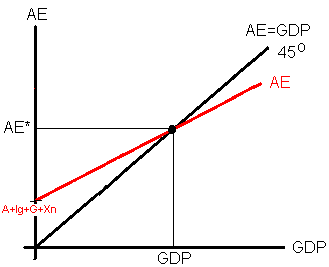
Note - Similar substitute C = A + (MPC)(GDP) into AE = C + Ig + G + Xn
| GDP* = multiplier [A + Ig + G +Xn] |
Shifting the Aggregate Expenditure Function
- Example 1 - President Bush gives every family $600
- Increases autonomous spending
- The $600 is independent from GDP income
- A.E. function shifts upward by $600
- GDP increases more than $600 from the multiplier effect
- Increases autonomous spending
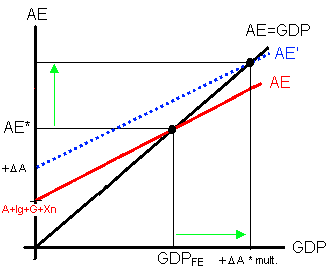
- Example 2 - Businesses are pessimistic about the future
- Businesses decrease gross investment
- A.E. shifts downward by the decrease in gross investment
- GDP decreases more than the drop from investment, because of the negative multiplier effect
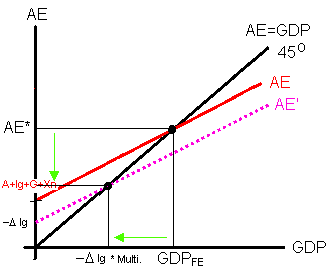
- Example 3 - Government increases government spending on the military, in order to invade a country
- A.E. shifts upward by the increase in government spending
- GDP increases more than the increase of government spending because of the multiplier effect
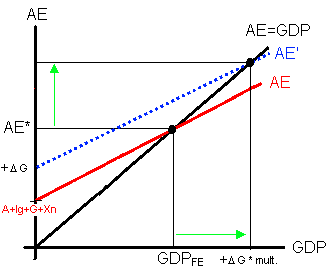
- Example 4 - Incomes for foreign countries fall from the 2008 financial crisis
- Demand for U.S. exports fall, thus net exports fall
- A.E. shifts downward by the decrease of net exports
- GDP falls more than the decrease in net exports from the negative multiplier effect
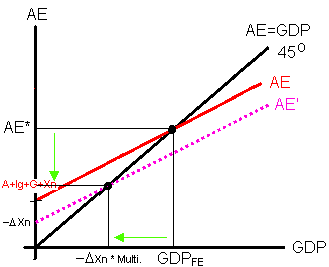
- Recession - GDP falls below the full-employment GDP
- Decrease in consumer spending (A or MPC)
- Decrease in government spending or increase in taxes
- Decrease in business gross investment
- Exports decrease or imports increase
- Demand pull inflation - if A.E. increases where GDP grows faster than the full-employment GDP
- Increase in consumer spending (A or MPC)
- Increase in government spending or decrease in taxes
- Increase in business gross investment
- Exports increase or imports decrease
- Model is simple
- Many things in the economy are occurring
- U.S. net exports have been negative for 40 years
- Counter balanced from strong business investment, government spending, and consumer spending
| A.E. is only one graph of the economy. Macroeconomists use several graphs to explain how economy respond to changes in economic events. |
Terminology
|
|